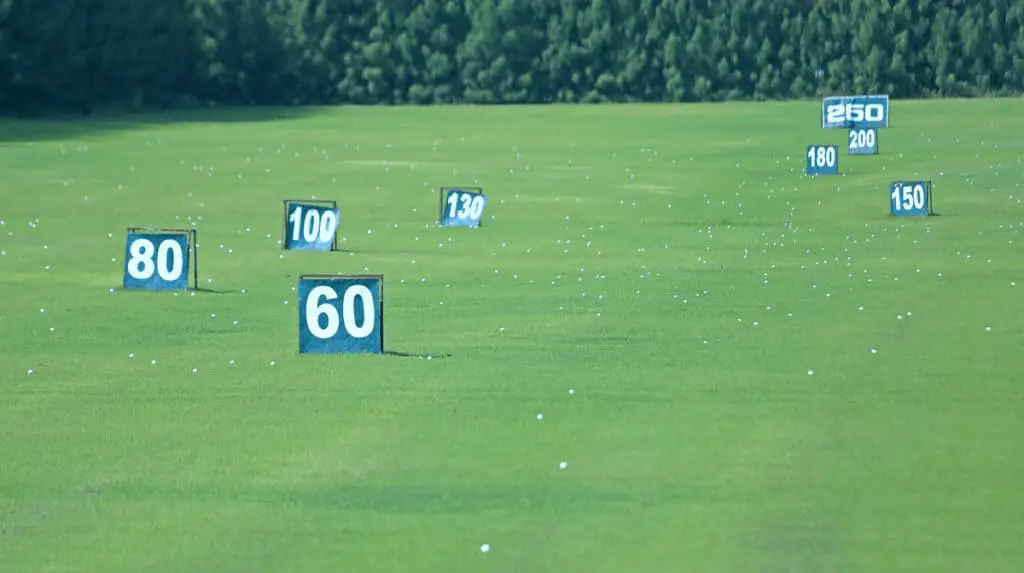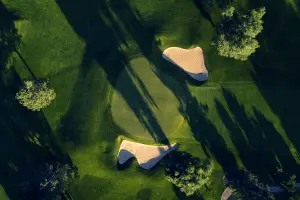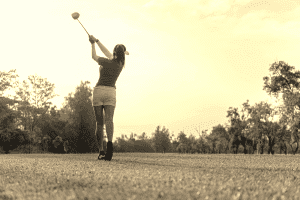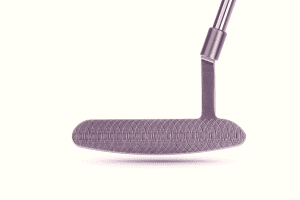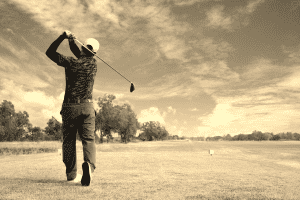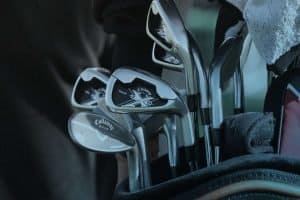There’s no nicer feeling watching that golf ball rocket off and disappear into the distance. With that said, if you don’t know how far you hit each club, you’re going to struggle in the game of golf. Some players know their exact yardages to the single yard, which goes a long way when you’re looking to regulate greens and shoot low scores.
Knowing how far you should hit each club isn’t all about range. By knowing your golf club distances, you can ‘calibrate’ your range to know what you are capable of. This article looks at how far you should (or could) be hitting the golf ball and some ways to get each shot perfect.
How Far Should You Hit Your Driver?
I think it goes without saying that we all want to hit our driver as far as we can. At the end of the day, distance matters. By being further along the fairway, you make your approach shots into the green much easier. It goes without saying that a 120 yard approach is going to hit the green more often than your 190 yard approach.
Here’s how far you should expect to hit a driver:
- Beginners and high handicappers: 200 yards
- Mid Handicap Players: 250 yards
- Low Handicappers/Scratch Players: 300 yards
If you are a beginner and think that looks a little low, I wouldn’t worry too much. A study by the USGA shows that the average drive distance in 2018 was around 220 yards! You should check out the rest of the study… It’s actually really interesting (and certainly made me feel ‘above average’… Even if I’m not!)
Tips To Hit Your Driver Further
It’s one thing to know you want to hit your driver further, and another thing to implement changes to hit longer drives. Here are a few key tips.
Learn to hit a draw
Ever noticed that a hook rolls further than a slice?
Here’s a simple fact. A draw goes further than a fade. The carry might be similar, but you’ll get more roll when the ball lands.
I’ve got a great guide on how to hit a draw here. It isn’t the easiest shot to master, but straighter shots are preferable to a fade even if you don’t manage a draw.
Hit up on the ball
Unlike with irons, a driver doesn’t impart lots of lift, creating backspin. As a result, you need to give the ball a helping hand in getting airborne. A great way to achieve this is to ‘hit up’ on the golf ball with your driver shots.
The way to do this is to make sure that the ball is positioned forward in your stance. This way, the driver makes contact with the ball just slightly after it has reached the lowest point and is ascending in the swing.
You also want to add a little tilt to your stance. The line of your shoulders needs to be pointing ever so slightly skyward.
Want a little more of a visual? Here’s a great video from our friends at Me And My Golf:
Create a wide stance and use ‘big’ muscles…
Watch any big hitter, like, say, Bubba Watson. Look at his stance. Wide and rock solid.
The reason for this is that they want to generate tremendous club head speed. Using the ‘big muscles’ of your core and legs to pull the club around is a really efficient way to add mph to your swing and more distance to your shots.
Want to see all of the above in practice?
Check this out…
How far should you hit your woods?
Ok, full disclosure.
When hitting fairway woods, I’m happy if the ball gets airborne at all! Hitting fairway woods off the deck isn’t the easiest, which I’m sure many golfers would agree with.
That said, if you catch them clean, you can see significant distance and be well down the fairway.
Here’s how far you can expect to hit fairway woods.
- Beginners and High Handicappers: 180 yards
- Mid Handicappers: 230 yards
- Advanced players: 250 yards+
Unlike a driver, where you’ll (normally) hit from a tee at a set height, fairway woods have an added variable.
The lie is not a constant, and as a result, there can be minor (or major) variations in the distance on the day.
It isn’t easy to consistently drill fairway wood down the middle. Here are a few tips and a handy drill to help you pick that ball off the turf and send it on its way.
Bring the ball back in your stance
You aren’t going to have the luxury of hitting up on the ball when you are on the fairway.
A ‘topped’ 3-wood? We’ve all been there.
Instead, you are looking for the club to make contact at a more neutral point. This occurs at the very bottom of your swing. The ball needs to come back in your stance and more towards the center to encourage this.
Hit down slightly | ball first, divot after
Unlike your irons, your fairway woods are not designed to cut through the turf. If you contact the ground before the ball, there’s a good chance that the clubhead will skip, bounce or twist.
The best you’ll be able to hope for in this case is a thin shot. The solution is to make a conscious effort to feel like you are hitting down on the ball slightly.
To envisage this, try and make your aim to strike the ball first and then take a really shallow divot just after the ball.
Here’s the drill
Actions speak louder than words, and the best way to get the feel and muscle memory required is to do a really practical drill.
Try this:
Insert a tee until it is flush with the ground an inch or two after the golf ball. When hitting your shots, the aim is to strike the ball and see if you can tap (or completely remove) the tee while making your shot.
You should find that you are striking the golf ball first, hitting ever so slightly down, and managing to make a scuffed divot on the tee peg with a little practice.
If you want to get a really great visualization of how all of the above works, check out this Rick Sheils video for an awesome visual.
How Far Should You Hit Your Irons?
Irons are a little variable. Obviously, a 4-iron is going to carry much further than an 8-iron. This is down to the variable lofts in your iron set.
To make life easier, check the table below for a range of irons and skill levels to get a really great idea of how far you should hit your irons.
| Iron | Beginner | Intermediate | Advanced |
| 3 | 160 | 190 | 200 |
| 4 | 155 | 185 | 195 |
| 5 | 150 | 180 | 190 |
| 6 | 145 | 175 | 185 |
| 7 | 140 | 170 | 180 |
| 8 | 135 | 165 | 175 |
| 9 | 130 | 160 | 170 |
Why your irons come up short sometimes…
Again, we’ve all been there. It was 180 to the flag. We hit the ball sweetly. Yet, we have come up short. Why?
There are plenty of reasons why irons come up short. Let’s run through a few:
Climate and Aerodynamics
Warmer air is less dense and produces less lift than cold air. Humidity also affects the flight of the ball. If you have an iron that normally travels 150 yards, but if the temperature and humidity affect the lift by 5%, you’ve just lost around 7 yards! That’s a whole club down!
Ball Temperature
If you’ve ever played squash, you’ll know that it takes a while for the ball to perform predictably. This is because the ball is cold.
The same is true of golf balls. They compress easier and transfer the club’s energy better when they are warmer. An easy fix is to carry a couple in your pocket and alternate them between holes.
Swing Speed
Swing speed is variable. You’ll have good days and ‘off’ days where your swing speed varies. The above table is produced using average swing speeds that you’d expect to see between different skill levels. As you can see, the slower the swing, the shorter the shot.
Your Swing | It’s Down to You!
If you are suffering a chronic loss of distance in your irons, there’s a good chance that you are creating too lofty a flight at impact. More loft does equal higher flight, but it can also mean less overall distance.
To deloft your clubs (and play with irons correctly), you should be seeking to remove some of that loft during your swing.
We do this with shaft lean and clubhead lag.
Shaft lean is when your hands are slightly ahead of the clubhead during the downswing. By promoting shaft lean, you are hitting down into the ball, compressing it against the ground, and increasing its exit speed from the clubface.
A great way is to deloft the club is to make use of a golf impact bag. If you check my article, you’ll see plenty of drills designed to promote a hands-forward approach.
There are quite a few drills you can try to deloft your iron shots and get (relatively) low penetrating ball flights without an impact bag. Here’s a great example…
Moving the Arc | Miss ‘the line.’
A simple visualization is to imagine your clubhead drawing a circle during the downswing. The bottom of the circle represents where your club will make contact with the ground.
Try to imagine moving this circle a little closer to the target. The aim is to make ground contact after the ball.
A more practical way to ensure this happens is to imagine your ball sitting on an inch thick line. The aim is to hit the ball without breaking the line. The only way you’ll achieve this is to hit down on the ball and make contact with the ground beyond it.
If you practice this drill regularly, you should find that you will make much crisper and cleaner irons shots and gain a lot more distance.
If you want to see an excellent visualization of this drill and technique, I’ve found a video that demonstrates it perfectly.
Better iron shots in 10 minutes? Sounds good, right?
How Far Should You Hit Your Wedges?
This is an interesting question…
There’s something you need to remember.
Wedges aren’t meant for distance. If your driver is a bazooka, you can think of your wedges as a high-precision sniper rifle. The aim of a wedge is to produce a dialed in approach shot to give you a nice easy putt.
It’s nice to say you can smash a pitching wedge 140 yards, but how much benefit do you gain from that? Suppose there’s a 20% variation in your wedge distance (which is realistic). In that case, you might be short by 30 yards, so you have saved yourself nothing, especially when you consider that the ‘harder’ you swing, the higher the chance of being inaccurate.
A good average for a wedge (regardless of your skill level) should be around 100 yards. You can have a couple of wedges to ‘fill the gaps’. I use a 56° wedge for anything under 100 yards and a 52° wedge for anything up to about 120 yards, as a point of reference.
If you are struggling for distance with your wedges, it is probably a better idea to go down a club or two. Hit a soft 52 instead of a hard 56, for example. That way, you get the right measure of distance and accuracy.
Final Thoughts
Which is more important… Distance or accuracy?
The true answer is probably both. When discussing golf club distances, it pays to appreciate that the two aren’t mutually exclusive. However, try too hard for distance, and you may find that your accuracy suffers.
There’s no harm in trying to ‘up your game’ and give yourself a little extra distance. And there are ways and means to achieve it. But if you aren’t a big hitter, don’t worry too much. Who cares if you take a 5-iron instead of an 7? It’s the numbers on the scorecard that matter more than a high five from your buddies!
Whatever you are hitting into the green, I look forward to seeing you on the course!

